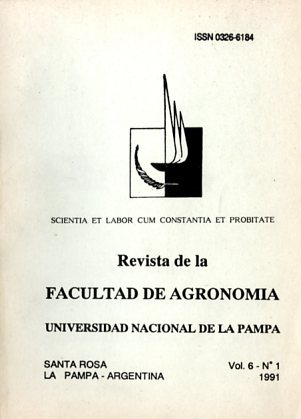Effect of premature weaning on litter performance and weaning-to-estrus interval in sows
Keywords:
Prematures weaning, Primiparaus sows, Weaning-estrus intervalAbstract
The aim of the present study was to evaluate the possibility of increasing the reproductive performance of the sow by reducing the normal period, without effect upon the potential production of the litter, Primiparaus sows with their litter were maintained under confinement and divided into 3 treatments with replications ach within a randomized blocks design Statistical analysis were performed through analysis of variance and test of Tukey. Treatment one (T1) consisted of a control with suckling period of 56 day. T2: 42 days and T3: 35 days. AU the 50WS received a feeding level of 1 of Iiveweight plus 300 g, on dry matter basis per suckling pig, once a day during the morning; the pigs were fed with a commercial prestarter feedsluff "ad libitum" from the 141h day lite. The parameters measured in this study were: liveweight al the end of lactation and date of first estrus alter weaning in the sows. Mean Iiveweight gain in pigs was different (P>0.05), (T1: 13.44 T2: 13.38, T3: 13.74 Kg), differences in pre-starter intake were highly significant (P<0.01) between treatments (T1: 14.45 kg, T2: 21.48 Kg, T3: 19.09 Kg), mean Iiveweights of the sows at the end of the suckling period were different (P<0.05), being the lowest one for T2,(T1: 157 Kg; T2: 139 Kg; T3: 156 Kg), probably due to the high number of suckling pigs per 50W during the 42 days of n, (T1: 6.33; T2: 9.66; T3: 6.66). One hundred percent of the sows were pregnant alter first estrus postweaning to 5 days, except for n, that required 3 more days lo appearance of first estrus. The sows receiving T1 had the lowest intake of energy and protein per suckling pig. It was concluded that a short lactation decreases pregnancy interval, although the weaning first estros period can be affected in primiparaus sows with large number of pigs/litter. The 3 weeks old pigs has already reached a complete digestive development, therefore, it is possible and easy to use early weaning as management tool.
Downloads
References
BERESKIN, B.; FROBISH, LT. 1981. Some genetic and environmental effects on 50W reproductivily. Joumal al Animal Science,53:601-610.
BRAUN, R.O.; CERVELLINI, J.E.; ALVAREZ, G.O.; SANTOS, M.C.; ZAMPA, H.H. 1989.
Empleo de sustituto lácteo en la alimentación de cerdos lactantes. Revista de la Facultad de Agronomía, UNUJam. vol., N° 1: 9-22. Argentina.
BUITRIAGO, J.A. 1977. Sistemas de producción de cerdas lactantes. Serie E.S. '26. Centro Internacional de Agricultura Tropical, CIAT.
CUNHA, T.J. 1983. Nutrición y alimentación de los cerdos. Ed. Hemisferio Sur. 352 pp. Argentina.
HAlMAGEAN, P.; MILOS, M.; CARPANU, F.; SlNETEAN, S.; UXANDRU, B. 1986. Preparation of and tests on a powdered milk. replacer in mixed feed for piglets. 4. Growlh and development of piglets and feed evaluation. Pigs News and lnfonnation, vol. 7 N· 3: 363.
NELSSEN,J.L; LEWlS, A.L.; PEO, E.R.; CRENSHAW, J.D. 1985. Effect of dietary energy enlalce during laelation on perfonnance of primiparaus sows and their Iilters. Joumal of Animal Science, 61: 1164-1171.
OLSEN, C. 1984. Alimentación de lechones. lNTA. EERA Pergamino. Alimentación, N· 17: 8. Argentina.
PINHElRO MACHADO, LC. 1973.Los cerdos. Ed. Hemisferio Sur. 526 pp. Argentina.
Downloads
Published
Issue
Section
License
La Editorial de la Universidad Nacional de La Pampa (EdUNLPam) exigirá a los/as autores/as la firma del siguiente documento:
La EdUNLPam lleva a cabo la publicación del artículo: (Título del Artículo) en SEMIÁRIDA Rev.Fac.Agron UNLPam ISSN 2362-4337 (impresa) ISSN 2408-4077 (en línea), del cual el/los abajo firmantes son autores de una o más partes. En el mismo acto, el/los autores entregan exclusivamente a la EdUNLPam todos sus derechos protegidos por las leyes de propiedad intelectual que rigen en la Argentina para reproducir, publicar, editar, fijar, comunicar y transmitir públicamente en cualquier formato o medio impreso o electrónico, inclusive internet, el artículo enviado a publicación e incluirlo en índices o bases de datos nacionales e internacionales. A cambio, la EdUNLPam entrega a los autores la autorización para la publicación o reimpresión con ines académicos y educativos en cualquier libro o medio de divulgación, con la sola obligación de citar el artículo original publicado en la EdUNLPam. Cada autor acuerda en que el material provisto a la EdUNLPam es un trabajo original, que no ha sido impreso o publicado en cualquier otro medio con anterioridad y que no vulnera derechos de terceros. El Primer autor tendrá la posibilidad de leer y corregir el artículo ya editado como “prueba de galera”, pero si el autor no devolviera esas correcciones de la prueba de galera dentro del tiempo especificado, el proceso de producción y publicación podrá proseguir sin la aprobación del autor. El/los autor/es no recibirán compensación monetaria de la EdUNLPam por el uso del material contenido en este artículo y asumen la responsabilidad de las opiniones vertidas en él.






.png)



22.png)



.jpg)




.jpg)
